Following up on a previous article on Cable Row Technique and today I want to examine the “other” major back movement and look at lat pulldown technique. As with previous technique articles, I’ll examine what muscles are trained, proper form and look at some variations on the movement.
Note: the form issues I’m going to address go for chins or pullups as well. The only difference is that instead of pulling the bar down to your body, you pull your body up to the bar. But the technique is otherwise identical. As well, I’m going to use the term pulldown generally throughout this article, just keep in mind that it refers to all of the different variants as well as chins/pullups.
Table of Contents
Muscles Trained in the Lat Pulldown
As the name itself suggests, the lat pulldown has as its primary target the latissimus dorsi. This is the large fan shaped muscle that takes up an exceedingly large portion of the back. While the midback is involved somewhat in the pulldown movement (depending heavily on how it’s done), the vertical line of pull tends to take the midback muscles out of the movement.
Since the arms are involved and there is bending at the elbow, of course the various elbow flexors, the biceps and brachialis, are also involved. Much of which is involved and to what degree depends on the grip used; I’ll cover this more below.
Lat Pulldown Technique: Introduction
With most pulling movements, including the Cable Row, many lifters tend to complain of not being able to “feel” the back. They may get a tremendous arm pump but the lat seems to go unused. As usual, this generally has to do with improper form (which is often secondary to using far too much weight).
One of the key aspects of getting the lats involved has to do with what happens at the shoulder. In a properly done pulldown the shoulders should elevate (move up) at the top of the movement and active shrug down at the end (in the Cable Row the shoulders move forwards and backwards).
If the shoulders aren’t moving down during the pulldown, it’s an arm movement. One good cue that has been around for years is to think about pushing the elbows down, as opposed to pulling with the arms. This tends to put more focus on the lats rather than the biceps.
A third and important issue (illustrated below) is that the torso needs to remain upright or, ideally, with a slight arch in the low back. If you think about lifting your chest to the bar as you bring the bar down (or pull yourself up in a chin), you’ll get it right. If you’re hunched over at the bottom, you’re getting a wonderful workout for your abs but not effectively training your lats. I’ll cover each of these issues below.
Basic Lat Pulldown Technique
First I want to look at basic pulldown technique. The two pictures below show the basic start and finish position for an undergrip pulldown. Note that the lifter is slightly behind the bar so that the bar can come straight down to the top of the chest.
In the finish position, the shoulders are down and back and the chest is up, the elbows are slightly behind the torso (indicating full lat contraction). I’ll cover this more fully in the section on variants but, of all the types of pulldowns I’m going to cover, this tends to put the biceps in the best line of pull. Most lifters will be able to use the most weight with this grip and performing this movement often decreases the need for direct biceps work to some degree.
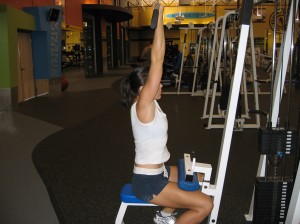

One important issue with all pulldowns is proper grip width and the picture below shows the proper grip width for the undergrip pulldown. Note that the forearms are exactly perpendicular with the bar. This is important and folks who start with grips that are either too wide or narrow (not shown but I think you can guess what this looks like) often complain of wrist or elbow problems.

There are several common errors that occur with pulldowns and while I’m going to demonstrate them with the undergrip pulldown, you can usually find people doing them with all of the variants I’m going to discuss later in the article.
In the left picture below, the bar is being pulled far too low. Somehow, folks find a way to turn pulldowns into a triceps pushdown at the end. In the right hand picture, the lifter is leaning too far back and turning the movement into a mid-back exercise. This usually happens when the weight is far too heavy and the lifter ends up using mostly body English and cheating to make the rep. But it isn’t a lat pulldown.


As I mentioned up above, one of the far more common errors with pulldowns is lifters ending up hunched over, this usually happens when the weight is too heavy. While it make the movement a great ab exercise, it’s not ideal for training the lats. Below I’ve shown a lifter hunched over (left picture) compared to the proper ending position with chest high and lower back slightly arched (right picture).
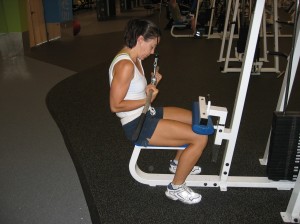
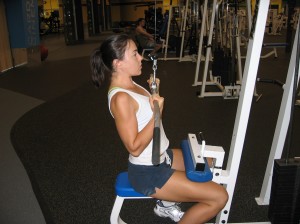
Correcting the above is usually a function of both reducing the weight and cueing the lifter to think about lifting their chest to the bar as they pull the bar down. If the lifter can’t do this, they have to keep the weight lower until they can. Again, on chin/pulldown variants, the same cue holds and the lifter should think about lifting their chest to the bar as they pull themselves up.
Lat Pulldown Variations
Like the Cable Row, there are numerous variations on the lat pulldown primarily involving changes in grip position (underhand vs. overhand) and width. Since the lats do have different functions at the shoulder and lines of pull, varying the type of pulldown done can certainly be beneficial from both a strength and hypertrophy standpoint.
Medium Overgrip Lat Pulldown
The first variation I want to look at is the medium overgrip pulldown. Unlike the undergrip pulldown which works the shoulder extension function of the lats, the medium overgrip pulldown works humeral adduction. As well, the biceps have a poorer line of pull and most lifters will not be able to use as much weight in this variant as with the undergrip pulldown
Proper grip width for the medium grip overhand pulldown is shown in the left picture below, while bars vary, generally speaking the hands will go at the ‘bends’ in the bar. of more importance is that the forearms, again, should be perpendicular to the bar with the elbows flared as this ensures that adduction is being trained.
The right picture below shows the finishing position. As with the undergrip pulldown, the bar is pulled to the top of the chest, the lifter’s torso is upright (or slightly arched back) with the chest high; the shoulders are down and the elbows are down and back.
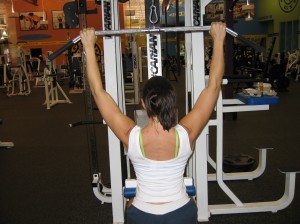
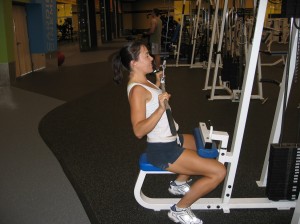
The same basic form errors, pulling the bar too low leaning too far back or ending up in a hunched over position can happen with this variant of the pulldown as well (the triceps extension variant where the lifter takes the bar all the way to the legs is more common because of the grip) and I’m not going to show those.
I’d note that the overgrip pulldown is often done with a very wide grip, hands out to the ends of the bar. The original idea was that ‘a wide grip equalled wide lats’ but this is basically nonsense. The very wide grip tends to limit the range of motion of the pulldown severely and it’s not a variant I ever see much need to use. I’d rather someone use the slightly narrower grip shown above and get a full range of motion.
Parallel Grip Lat Pulldown w/V-Handle
Next up I want to show a variant of the pulldown using a parallel grip on a V-handle. This variant works the shoudler extension function of the lats (like the undergrip pulldown) but I have found that some find it a bit easier on the wrists and elbows.
The parallel grip tends to hit the brachialis a bit more and biceps don’t have a fantastic line of pull but most will find that their poundages on this are a little bit less (but close) to the undergrip pulldown but higher than a medium overgrip. The proper starting and finishing position for the parallel grip pulldwn are shown below.


The Behind the Neck Lat Pulldown
Finally I want to look at the behind the neck pulldown. In recent years, similar to the behind the neck press, there has been a bit of controversy surrounding the movement with many arguing that it is harmful to the shoulder (and does nothing that other, safer variants, can’t do). And certainly there is some truth to this.
However, I tend to think that the bigger issue with the behind the neck pulldown is as much to do with the flexibility of the average trainee as anything else. Lifters with poor shoulder flexibility (i.e. most of them) tend to have problems because they can’t do the movement in anything approximating proper form. This will make sense in a second.
Generally, a behind the neck pulldown would start with a grip more or less identical to the medium grip overhand pulldown. A major change is that the lifter should now move so that they are slightly in front of the bar in the starting position; this is so that they can pull the bar straight down and not have to lean forwards or do goofy stuff with their head.
I’ve shown the proper finish position for a behind the neck pulldown in the left picture below. As you can see, the elbows are directly in line with the torso and the head and chest are both up.
In the right picture, I’ve shown what usually happens when lifters try to do this movement. A complete lack of shoulder flexibility, usually going hand in hand with poor posture (shoulders pulled forwards) leads to the right picture and this is bad. That causes the elbows to rotate back and the chest and head to drop forwards.
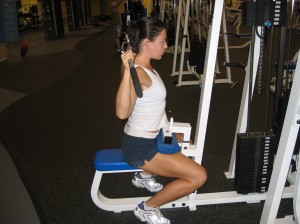
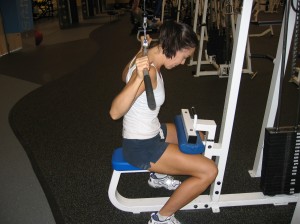
Of course, the right hand picture can happen even when lifters have good shoulder flexibility but are using too much weight.
Other Lat Pulldown Variants
Of course, there are more variants than this that I can’t cover. One handed pulldowns are not unheard of and there are actually some decent pulldown machines. The Hammer Strength Behind the Neck Pulldown is actually excellent in that the handles go outside the head while keeping the elbows right in line with the torso. It is one of my favorite machines for training the lats.
Another movement that can often be useful is the lat shrugdown. This is simply a pulldown without the arm bend, the focus is on letting the shoulders elevate slightly and then shrugging down hard by using only the lat. I have often used this to teach lat involvement in the movement, or as a way to finish a set (after the biceps have fatigue). It can be used as an exercise in its own right.
Just keep in mind that for basically all pulldown (again, or chin/pullup) variants, the same basic cues and technique tips hold. The shoulders must elevate slightly and depress at the end of the movement, the chest should be kept high with the torso either vertical or slightly arched in the low back. If you’re having to use funky form, you’re using too much weight and, odds are, you’re not training the lats in the first place.
Similar Posts:
- Cable Row Technique
- A Guide to Bench Press Technique
- Split Squat Technique
- Clean Style Deadlift Technique
- Bench Press Variations
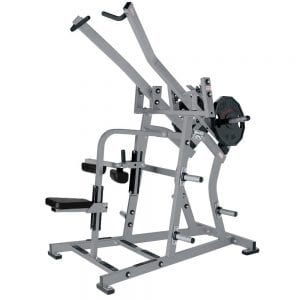
Lyle,
The pre-fatigue method is often suggested as a “learning” technique for those who tend to have trouble feeling the lats working with these exercises. Have you found that in most cases it is simply about checking the ego and being more strict with form? Or are there a fair amount of times when a lifter may genuinely be dominant enough in the elbow flexors where the use of the pre-fatigue method early on to get the feel followed by the post fatigue method further down the line to maximally stimulate the lats would actually be necessary?
Sorry for the second post, Lyle, but I also wanted to ask what you think of using an incline bench (lying prone) in a cable crossover (using the two high pulleys) or with a functional trainer to allow the arms to go out in a wide “V” shape and then execute a pulldown motion pulling the elbows in close to the ribs. This seems to allow for a wide “grip” but without the ROM limitations encountered with the bar versions.
Hi, Lyle.
Do rack chins have pros over regular chins/pulldown?
Thanks.
Hi Lyle
A very interesting post. Is there a dfference between the lats used as a humerus adductor or used for shoulder extension on lat hypertriphy or strength development? Secondly is a row exercise more efficient as it works the lats and the mid back or does it not hit the lats hard enough?Thanks for the info. I check this blog every day. Its fantastic.
Martin
Pull ups are better than pull downs so I prefer them!
Hi, Lyle,
I once read a quote by Arnold saying if you wanted wide lats, do 50 wide-grip pull-ups per session, doesn’t matter how many sets. So I doubled it, and did between 100 and 105 using a 1 through 7 ladder pattern three times per week.
This was working great for a month or two, my lats were visibly growing, but then I realized I could no longer fully straighten or close my right arm (at the elbow). It’s been two months now, got ART massage, etc., but I still can’t either fully extend or fully close (i.e., can’t grab my neck). I’m fairly heavy — 102kg / 225 lbs — so it added up to over 10,000 kilos per session. Perhaps stupidly, I kept doing the pull ups even while trying to get the elbow fixed with massages, etc.
Except for using a wider grip than you recommend, I was doing everything “right” (as described by you, above). Is this sort of injury common? And any ideas how to fix it?
Thanks!
Jack: Depends on the specifics. With beginners, it was always usually necessary for me to teach them how to use the lats or midback with shrugbacks or shrugdowns. But even with lifters who have been doing it for years, someties neural retraining along with checking the ego is relevant. The movement described in your second post is another way to train the lats, yes.
Martin: If you look at the line of pull on the lats, there are sort of two different ‘sections’ with one set of fibers running more horizontally and the other more vertical. For optimal growth, a combination of adduction and extension work is probably best. Then again, go heavy enough in good form and it probably doesn’t matter. For strength, neither is better, they are simply different and it’s a matter of training the pattern that you want or need to improve.
Adrian: That’s nice but no exercise is inherently better than another, it’s matter of using the right tool for the job.
Bolidizar: I can’t diagnose an injury over the internet.
In what case Pull downs are better than Pull ups? I’m a huge fan of avoiding machines as much as you can and doing barbell or dumbbell exercises or bodyweight exercises instead. Pull ups is considered being one of the best back builders also… Pull downs still work though…
Cheers
I like supersetting the medium grip pulldown with the undergrip pulldown. Sometimes i use it as part of a giant set right after a few variations of the cable rows. The combination works great for me.
When teaching a beginner to do pulldowns I’d advise against letting the shoulders shrug up at the bottom. There’s a risk that being unable to feel the tension in their lats will mean they just relax and let the shoulder joint bear the load, which could cause injury.
Can the next article tell us what that model does for her legs? The sweep of her quads is beautiful!
Adrian: That’s not what I said. But the idea that pullups are INHERENTLY superior to pulldowns is the same kind of macho crap that says squats are ALWAYS better than other movemements. What movement is ‘best’ depends on context.
Julian: I disagree, I would rather teach proper technique from teh get go and that means learning to depress the scapula.
It looks like the proper form for behind the neck has the external rotators helping to pull the weight down as opposed to improper where it is internal rotators pulling it down.
Hi,
Great site. I just went through alot of articles and wow. Alot of great reading, also it was nice to understand the science behind Layne’s PHAT system as well as many other thoughts (it’s clear your a large influence).
My question is regarding bent barbell rows vs yates rows (overhand grip). Yates says that the 45 degreeish angle allows the lower back to be in a safer position and puts emphasis on the lats, while many ‘golden era’ body builders say the opposite, that pulling at parallel protects the lower back with emphasis on rhomboids, traps and lats. Could you shed any light on this?
Thanks so much!! You’re great
Hi.
I want to say that while doing overhand lat pull downs (humeral adduction), flaring the elbows causes the shoulder movement get out of the scapular plane. Horizontal abduction of the shoulder may cause the anterior shoulder capsule to stretch (more importantly, anterior shoulder instability may be triggered) especially with external rotation i.e. when forehand is not perpendicular to the floor and hands are going backwards.
Lyle, with the medium width, overhand grip pulldown, by “elbows flared,” you mean that the grip width is ideal when the forearm is perpendicular to the floor at the point during the movement when the humerus is parallel to the floor, correct?
Yes. They should stay more or less perpendicular to the floor all the way through.